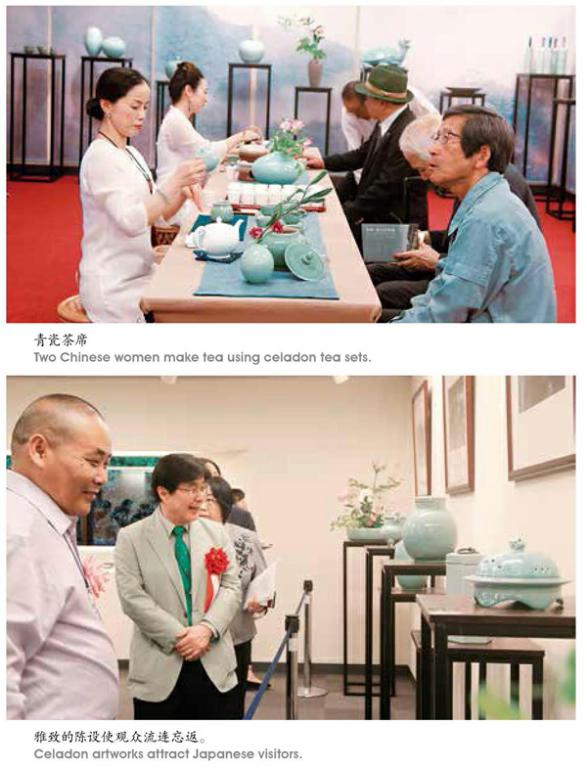龙泉青瓷,再渡日本
2017-09-14骆蔓黄芸
骆蔓?黄芸
展厅的一角传来极细且柔的江南丝竹的背景音乐声,好像是《采茶舞曲》,两名中国女子正用龙泉青瓷茶具演示中国茶道。与日本茶道的生活化程式不同,中国茶道更具舞台艺术的表现力,演示如淡云薄雾舒卷自如于茶山之间,让前来欣赏的日本观众感叹不已,纷纷竖起大拇指而频频点赞。
这中国茶道表演是“日本·浙江文化年”重头项目“龙泉青瓷生活主题展”中的主要节目之一,不久前在东京中国文化中心举行。日本是十分喜爱瓷器的国度,在本次龙泉青瓷展览上,日本民主党前党首海江田万里先生称,青瓷在日本人心目中是“神器”。

丝绸之路自唐代于海上开辟之后,首航地区便是日本群岛和朝鲜半岛。宋代以来、尤其是明清时期,经由海上丝路,中国向域外输出的货物中,排名最大宗的其实是瓷器,次之才是丝绸、茶叶等。中国瓷器本是生活用品,因器形、色彩、装饰、绘画的丰富多样,改变和提升了人们的生活方式和生活品质、生活品位,也同时产生有艺术的属性,能美化人居环境、培育人文素养。于是,中国瓷器承载了东亚文明、南亚文明、西亚文明和欧洲文明,并成为有相互影响作用、造成“文化循环”的“天下之器”。
由于地理远近关系,历史上日本于公元8或9世纪最先接触浙江越窑青瓷,而对龙泉青瓷的进口至迟能够寻溯到13世纪。在日本,除北海道外,其他三大岛都有早年的龙泉青瓷出土。1323年,中国一艘从浙江宁波到日本博多的贸易船在高丽新安沉没,650年后打捞出的近两万件中国瓷器中,有百分之六十为龙泉青瓷。17世纪,荷兰人打开了对日本的中国瓷器销售市场,“青如玉、明如镜、薄如纸、声如磬”的龙泉窑青瓷在其中格外受到欢迎,被民间广泛使用,而精品主要得到皇室、寺院、世家的收藏。
日本陶瓷学家三上次男先生,在他所著的《陶瓷之路——东西文明接触点的探索》中盛赞“宋代龙泉青瓷以其精湛的品质独步于世界”,并称这种瓷器的青色,其清澈犹如秋高气爽的天空,也如宁静的深海。
如今,这曾经的艺术品又逐渐生活化,重新走近普通人,成为现代生活的一部分,龙泉青瓷茶具就是最好的例证。本次展览现场,用龙泉青瓷茶具进行中国茶道表演,使这一艺术品的生活气息愈发浓郁。
有人说青瓷生活化是回归本真,说得对。记得法国诗人这样高歌:“给我倒杯茶吧,艾兰小姐,请用这样美的中国瓷杯。”(波德莱尔《给我倒杯茶》)德国汉学家雷德侯先生在他所著的《万物》一书写道:“瓷器能按照人的意愿成型;装饰方式多样;用后极易清洗,同时又坚硬、耐用;能发出铿锵声,加之其美如玉——光滑、白净、晶莹,而且半透明。”
而我们从当下文化交流的层面深入一点想,温润的青瓷、轻盈的茶叶,在身穿丝绸服饰的女子的清溪流水似的演绎下,体现的正是海上丝路所传播的瓷器、丝绸、茶叶的历史作用和意义,婉转反映出古代中国文明与包括日本在内的各国文明的一衣带水。
龙泉青瓷一度断代,恢复以后的工艺越来越熠熠生辉。本次展出的龙泉青瓷共有百件,在工艺美术的设计装饰上,造型、釉色、纹片无不精彩,我们看去,“青瓷薄胎”“青瓷玲珑”“青瓷釉下彩”“象形开片”“文武开片”“青白结合”“哥弟窑结合”,大约都在。

面对这样优雅大气、莹润如玉的龙泉青瓷作品,日本嘉宾纷纷表示,如此规模和水平的龙泉青瓷来日本展出难得一见。历史上海上丝路延伸至古都奈良,陶瓷也从中国传到日本,于17世纪出现田瓷器(伊万里瓷),现在更发展成一眼就能明显看出日本特色的陶瓷工艺,希望文化交流的硕果惠及两国人民。
爱好摄影的公司职员田中先生围着展品拍个不停。他说:“龙泉青瓷就像包裹的美玉,给人一种神秘感,在镜头里更生动。真是太美了!”爱好瓷器的退休教员宫本先生一直在2016年G20杭州峰会国礼级龙泉青瓷作品双耳盘口瓶、吉祥如意之尊、双耳瓶前转悠,凝视久久,不愿离去。我们很想与宫本先生深入交谈,却又实在不忍心打扰。
绝没有料到本次展览在异国他乡如此受欢迎,龙泉青瓷艺人王武先生说:“能受邀到日本参展,对我来说意义重大。同行的龙泉青瓷作品精美绝伦,我也感到自豪,希望以后全世界都知道龙泉青瓷,让它的知名度越来越高。”激动之情溢于言表。
“中国瓷对世界史研究的最大价值,在于它反映了一项规模最为庞大的文化转型活动。”读过世界文化史的人知道,美国历史学家罗伯特·芬利先生,曾经在《朝圣者的艺术:世界历史中的瓷文化》一书中探讨,丝绸、茶叶被人消费使用而消失,“只有瓷器,不仅历时长在,还在文化相互影响上发挥了核心作用”。为了传播中国瓷器,开幕式上,浙江省工艺美术大师金益荣先生为日本的嘉宾和陶瓷匠人讲解龙泉青瓷:哥窑、弟窑的传说故事,龙泉青瓷的发展历史以及制瓷工具、原材料和拉坯、刻花等手工艺。与之配合,现场还展示了青瓷碎片、老龙窑和青瓷制作场景及工艺流程等老照片。这些讲解和展示,蕴含了龙泉青瓷背后的美丽动人的文化故事。
与通常的展览不同,本次展览专门从浙江龙泉运来一台传统手工拉坯机、龙泉青瓷常用的瓷土原料、制瓷工具等,进行拉坯和刻花的活态展示。龙泉青瓷的烧瓷技艺,是全球第一个、也是唯一入选联合国教科文组织“人类口述和非物质遗产代表作”名录的陶瓷类项目。
“三上次男先生在上世纪80年代专门来了一趟龙泉。他看到古窑的时候,立即双膝跪地,磕了三个头。”中国工艺美术大师、国家级非遗项目龙泉青瓷烧制技艺代表性传承人徐朝兴先生,在“龙泉青瓷生活主題展”出国前的杭州预展上告诉我们,为了表示尊重和崇仰,三上次男先生回日本时特意带了一捧龙泉窑泥,说这就是龙泉青瓷的土脉,值得永远收藏。endprint
我們在参展结束前,去市面购买了几件日本的生活类瓷器,这些实物将会与心中的本次展览一起永远收藏。
(本文照片由作者提供)
May 30, 2017 witnessed Zhejiang launching a Longquan Celadon exhibition in Tokyo, Japan. The year 2017 is designated as Japan-Zhejiang Year of Culture. The venue was China Cultural Center in Tokyo. The exhibition is a top priority on the agenda of the years activities.
On display were 100 celadon pieces, featuring all the characteristic charms and beauties of the ceramic consummated in Longquan in southern Zhejiang. Also on the show were a number of photos showcasing celadon kilns, celadon-making tools, and procedures.
At the launching ceremony, Mr. Jin Yirong, a master of arts and crafts of Zhejiang, gave a brief lecture on the genesis of celadon. Among the audience were Japanese VIPs and masters of ceramics. Masters from Zhejiang demonstrated their celadon art during the exhibition, which ended on June 9.
Japanese visitors responded warmly to the glory of celadon. Mr. Banri Kaieda, a statesman who served as the President of the Democratic Party of Japan between 2012 and 2014, visited the exhibition and marveled at the celadon exhibits, wowing that the ceramics looked like magic objects. Mr. Tanaka, an amateur photographer who was a white-collar worker in a Japanese company, took the opportunity to take pictures of the celadon. He commented that the Longquan Celadon was as beautiful as jade pieces and they looked vivid through camera lens. Mr. Miyamoto, a retired teacher, could not tear himself away from the celadon masterpieces custom-made for the G20 Summit 2017 held in Hangzhou, capital city of Zhejiang Province.
Celadon, produced in Longquan, was and is widely appreciated in Japan, a country which has a passion for ceramics. This passion was first kindled by the ceramics from China as soon as the Silk Road on the Sea opened up during the Tang Dynasty (618-907AD). In fact, the world-famous trade route on the sea first extended between China and Japan and Korea peninsula and, of the goods shipped through the trade route, ceramics ranked the biggest quantity, followed by silk and tea.
Essentially ceramics are for everyday life. Shapes, colors, and patterns are attractive. And they themselves are like decorative objects. They offer a touch of aesthetics and make life beautiful. Ceramics made in China have had a huge impact on civilizations across the world.
Close geographically to China, Japan first saw celadon made in Yue Kiln in the 8th or 9th century. The import of Longquan Celadon to Japan started very early. In 1323, a Chinese merchant vessel sailed from Ningbo to Hakata, a Japanese port city. The ship sank off the southwest coast of Sinan, South Jeolla Province, in todays South Korea. The shipwreck was discovered in 1975. Of the objects excavated from the underwater shipwreck are numerous Chinese ceramics. About 60% of the nearly 20,000 pieces of Chinese porcelains are of Longquan Celadon. In the 17th century, Chinese ceramics found a full market in Japan. Celadon from Longquan enjoyed popularity in the island nation. Celadon was as green as jade, as bright as mirror, as thin as paper, and as musical as the sound from the musical instrument “Qin”. The best celadon pieces went into the collections of the noble houses, Buddhist temples, and big families across Japan.
Mr. Wang Wu, a celadon master from Longquan who was with the Chinese exhibitors, was surprised to witness the warm reception of celadon in Japan. “It means a great deal to me to be at this exhibition in Japan. I am happy and proud that the celadon pieces made by my fellow celadon masters are well received in Japan. I hope Longquan Celadon can be made better known across the world in the future,” said Mr. Wang Wu emotionally.
The same exhibits had been displayed to the public first in Hangzhou before they were shipped to Tokyo for the Zhejiang Cultural Year in Japan.endprint
